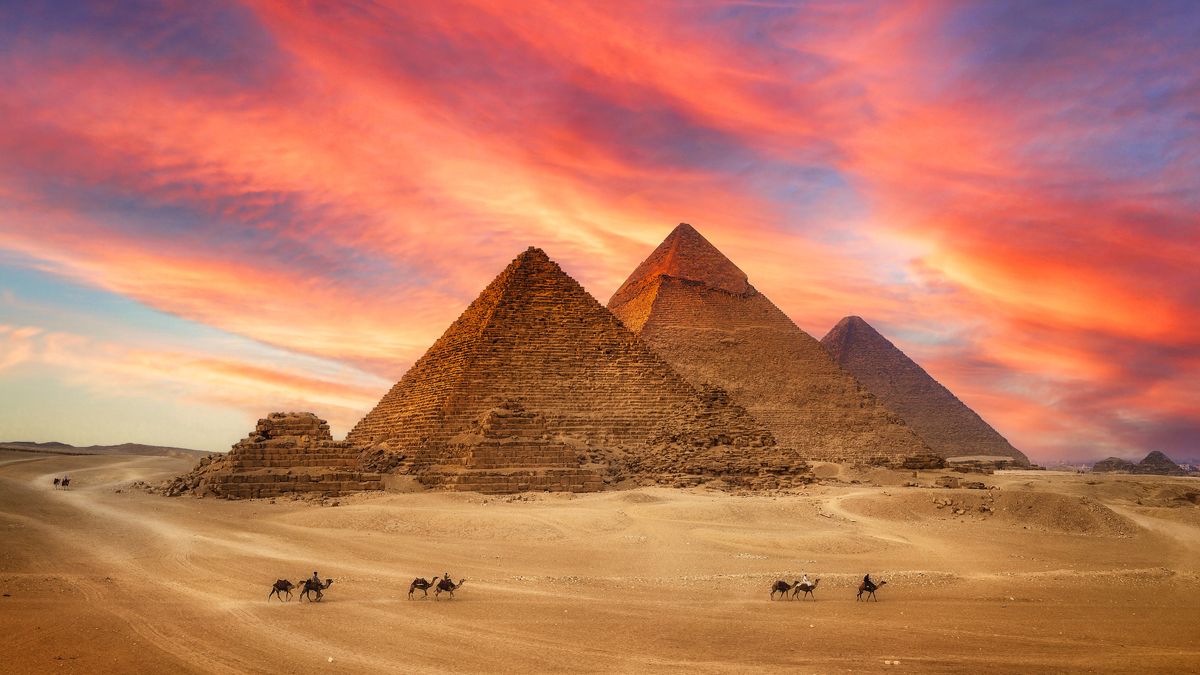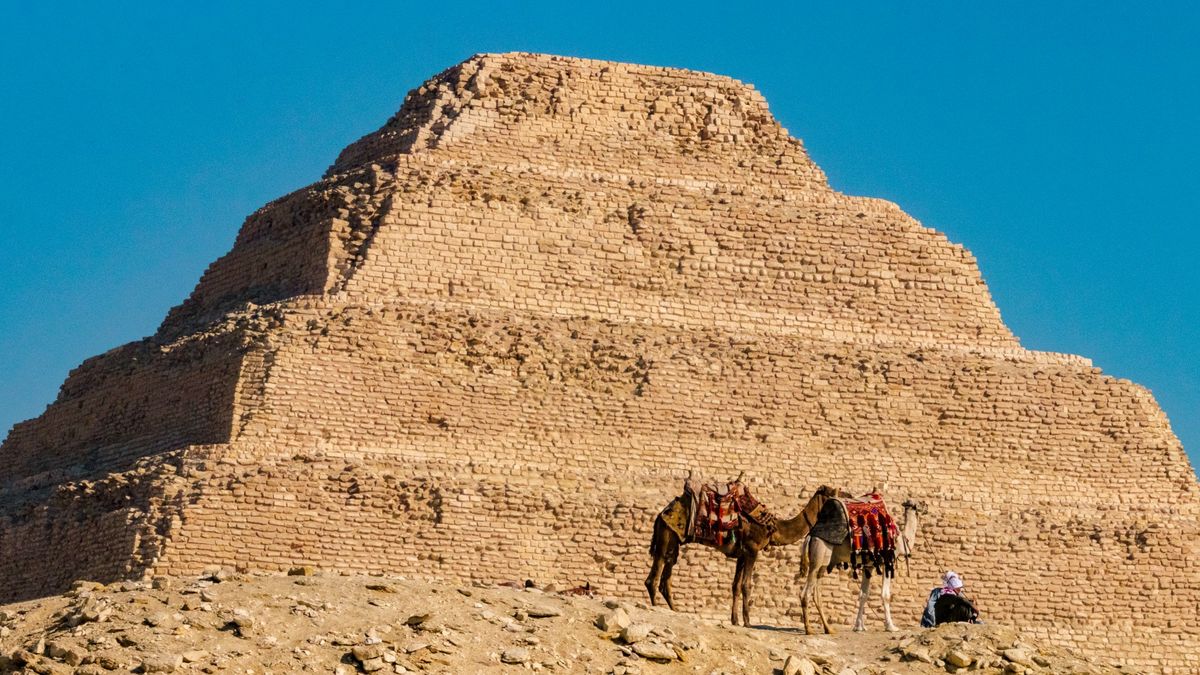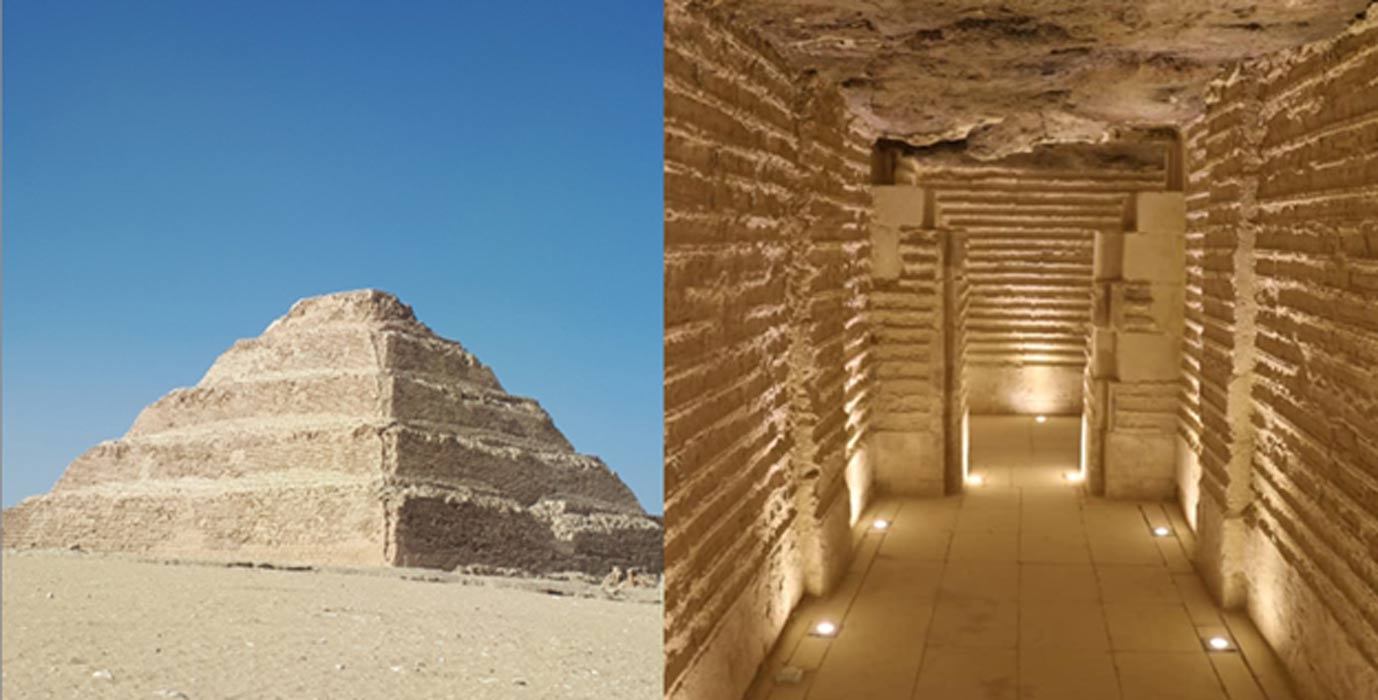The Saqqara Pyramid: A Must-See for Any Egyptophile

I. The Saqqara Pyramid: An Overview
The Saqqara Pyramid is a fascinating ancient structure in the Memphis Necropolis near Cairo, Egypt. As the first stone pyramid built in Egypt, it holds significant historical and cultural importance. This blog post will provide an overview of the Saqqara Pyramid and explore why it is a must-see for Egyptophiles.
Also known as the Step Pyramid, the Saqqara Pyramid was constructed during the 27th century BC for Pharaoh Djoser of the Third Dynasty. Designed by the famous Egyptian architect Imhotep, it stands as a testament to the ingenuity and architectural prowess of the ancient Egyptians.
This six-tiered pyramid structure is composed of limestone and reaches a height of approximately 197 feet (60 meters). Its unique design, with each tier slightly smaller than the one beneath it, creates a series of steps that give the pyramid its name. This distinguishing feature sets the Saqqara Pyramid apart from later pyramids, such as those at Giza.
The Saqqara Pyramid complex includes various other structures, such as courtyards, temples, and a mortuary complex. These additional elements contribute to the site's overall grandeur and historical significance.
Why the Saqqara Pyramid is a Must-See
Visiting the Saqqara Pyramid is a must for any Egyptophile and offers a range of compelling reasons to do so:
1. Historical Significance: The Saqqara Pyramid predates the famous pyramids at Giza, making it an essential destination for history enthusiasts. Exploring this ancient structure provides insights into the early development and evolution of pyramid construction in Egypt.
2. Architectural Marvel: The innovative design of the Saqqara Pyramid, with its step-like structure, showcases the architectural brilliance of the ancient Egyptians. Witnessing this unique architectural feat in person is awe-inspiring and allows visitors to appreciate the advanced engineering skills of the time.
3. Cultural and Religious Context: The Saqqara Pyramid is important to ancient Egyptian religious beliefs and practices. It served as a tomb for Pharaoh Djoser and was intended to facilitate his journey to the afterlife. By visiting the pyramid, visitors can gain a deeper understanding of the religious and spiritual beliefs of the ancient Egyptians.
4. Historical Artifacts: The Saqqara Pyramid complex has numerous artefacts and inscriptions that provide valuable insights into ancient Egypt's culture and daily life. These artefacts include statues, hieroglyphics, and intricate carvings, offering a glimpse into the region's rich history.
5. Surrounding Attractions: The Saqqara Pyramid is part of a larger necropolis, which includes other tombs and ancient structures. Visitors can explore nearby sites, such as the Pyramid of Unas and the Mastaba of Ti, to further enhance their understanding of ancient Egyptian civilization.
The Saqqara Pyramid is a must-see for any Egyptophile due to its historical significance, an architectural marvel, cultural and religious context, historical artefacts, and surrounding attractions. A visit to this ancient site is an opportunity to immerse oneself in ancient Egypt's fascinating history and culture.

II. History of the Saqqara Pyramid
The Ancient Egyptian Pharaohs and Pyramids
The Saqqara Pyramid in the vast Saqqara Necropolis near Cairo, Egypt, is a fascinating relic from ancient Egyptian civilization. The pyramids were built as extravagant tombs for the pharaohs, believed to be divine rulers. These remarkable structures were designed to ensure the pharaoh's journey into the afterlife and their eternal rule as gods. The Saqqara Pyramid is one of Egypt's oldest and most well-preserved pyramids, offering a remarkable glimpse into the ancient world.
Construction and Architecture of the Saqqara Pyramid
The Saqqara Pyramid, also known as the Step Pyramid, was commissioned by Pharaoh Djoser, who ruled during the Third Dynasty of ancient Egypt. It was designed by architect Imhotep, a prominent figure in ancient Egyptian history, and is considered one of his most significant achievements. The pyramid's construction began around 2630 BC and took approximately 20 years.
The Step Pyramid: The Saqqara Pyramid stands 203 feet tall and comprises six rectangular mastabas, or flat-roofed tombs, stacked on each other. This unique stepped design was a revolutionary departure from the traditional flat-roofed mastaba tombs, making it an architectural marvel of its time.
Complex Structure: The complex surrounding the Saqqara Pyramid consists of several other buildings, including courtyards, chapels, and smaller tombs. These structures were all built to serve specific purposes related to the pharaoh's burial rituals and offerings.
Decorative Elements: The walls of the pyramid complex were adorned with intricate carvings and hieroglyphs depicting scenes from ancient Egyptian mythology and religious beliefs. These decorations provided a visual narrative of the pharaoh's divine lineage and their role as a bridge between the earthly and divine realms.
Protection and Preservation: The Saqqara Pyramid was constructed using local limestone, contributing to its excellent preservation over thousands of years. However, time and human interference have taken their toll on the pyramid. Restoration and conservation efforts are ongoing to safeguard this ancient wonder and ensure its survival for future generations.
To learn more about the history and significance of the Saqqara Pyramid, check out this article.
The Saqqara Pyramid is a must-see attraction for any Egyptophile or history enthusiast. It offers a glimpse into the remarkable achievements of the ancient Egyptians and the architectural prowess of Imhotep. The pyramid's unique stepped design and intricate decorations make it an awe-inspiring sight. Witnessing this ancient wonder in person is an experience that will leave a lasting impression and deepen your appreciation for the rich history of ancient Egypt.

III. Exploration and Archaeological Discoveries
Early Excavations at Saqqara
The Saqqara pyramid complex: has long been a site of fascination for archaeologists and history enthusiasts. The early excavations at Saqqara began in the 19th century by prominent archaeologists such as Auguste Mariette and Flinders Petrie.
One of Saqqara's most significant early discoveries was the Step Pyramid of Djoser, built during the 27th century BC. This pyramid is considered one of Egypt's earliest monumental stone structures and served as a prototype for later pyramids.
During the early excavations, archaeologists also unearthed numerous tombs, funerary complexes, and statues, providing valuable insights into ancient Egypt's religious beliefs, art, and social structure.
Significant Artifacts and Inscriptions Found
Over the years, several significant artefacts and inscriptions have been discovered at Saqqara, shedding light on the rich history of ancient Egypt:
1. The Pyramid Texts: Dating back to the Old Kingdom period, the Pyramid Texts were inscribed on the walls of pyramids and tombs at Saqqara. These texts contain a collection of spells, rituals, and prayers believed to facilitate the deceased's journey to the afterlife. They provide valuable insights into ancient Egyptian religious beliefs and funerary practices.
2. Funerary Masks and Statues: Saqqara has yielded numerous funerary masks, including the famous gold mask of Tutankhamun. These masks were placed over the faces of mummified bodies to protect the deceased and ensure a successful transition into the afterlife. Additionally, various statues representing pharaohs, gods, and other prominent figures have been uncovered at the site, showcasing ancient Egyptians' craftsmanship and artistic skills.
3. The Tomb of Ptahhotep: Discovered in Saqqara, the tomb of Ptahhotep is considered one of the most important and well-preserved tombs from the Old Kingdom period. Ptahhotep was a high-ranking official during the reign of Pharaoh Djedkare Isesi. The tomb's walls are adorned with intricate carvings and hieroglyphic inscriptions that provide valuable insights into ancient Egypt's daily life and social hierarchy.
4. The Mastaba of Mereruka: Mereruka was a vizier during the Sixth Dynasty of Egypt, and his mastaba (an Egyptian tomb with a rectangular base and sloping sides) is one of the most extensive and well-decorated tombs at Saqqara. The tomb's elaborate reliefs depict scenes of everyday life, offering a glimpse into ancient Egyptian society, agriculture, and religious rituals.
These discoveries highlight the importance of Saqqara as a significant archaeological site and its role in deepening our understanding of ancient Egyptian history and culture. The ongoing excavations and research at Saqqara continue to uncover new artefacts and expand our knowledge of this remarkable civilization.
For more information about Saqqara and its archaeological significance, you can visit the Saqqara Wikipedia page.

IV. The Step Pyramid of Djoser
The Unique Design and Purpose of the Step Pyramid
The Step Pyramid, also known as the Pyramid of Djoser, is one of the most remarkable structures in Egypt and a must-see for any Egypt lover. Built during the 27th century BC, it is considered the earliest colossal stone building and a significant milestone in the evolution of pyramid construction. Imhotep, an ancient Egyptian architect and physician who served as the pharaoh's chief advisor during the Third Dynasty, designed this architectural wonder.
The Step Pyramid gets its name from its unique step-like appearance, consisting of six mastabas (rectangular structures with flat tops) stacked on each other, forming a pyramid shape. Unlike later pyramids, the Step Pyramid has a square base, measuring approximately 121 meters on each side, and reaches a height of around 60 meters.
The primary purpose of the Step Pyramid was to serve as the tomb of Djoser, the pharaoh for whom it was built. The pyramid was believed to function as a staircase to the heavens, allowing Djoser's soul to ascend and join the gods in the afterlife. The pyramid complex also included various structures and chambers associated with religious rituals and burial practices.
Features and Highlights of the Step Pyramid Complex
The Step Pyramid Complex is a vast architectural ensemble that includes several notable features and highlights:
1. Enclosure Wall: The pyramid complex is enclosed by a massive limestone wall measuring approximately 10.5 meters in height. The wall surrounds an area of about 15 hectares, providing security and privacy for the burial site.
2. Entrance Hall: The entrance to the Step Pyramid complex leads to an impressive collonaded hall known as the South Court. The hall is adorned with 40 columns, each topped with a beautifully carved palm capital, creating a grand and majestic atmosphere.
3. Funerary Complex: The central feature of the Step Pyramid complex is the funerary complex, consisting of underground burial chambers and the monumental stone superstructure. The underground chambers were the final resting place for Djoser's mummified body and burial goods, while the above-ground structures showcased the pharaoh's wealth and power.
4. Mortuary Temple: Adjacent to the Step Pyramid, a mortuary temple was used for religious rituals and offerings in honour of Djoser. The temple was connected to the pyramid via an impressive causeway, lined with statues and decorated with reliefs depicting scenes from the pharaoh's life and reign.
5. Courtyard and Serdab: The Step Pyramid complex also features a large open courtyard surrounded by ceremonial buildings and storage chambers. One of the most intriguing elements within the complex is the serdab, a small concealed chamber housing a statue of Djoser. The serdab had small openings to allow the pharaoh's ka (spirit) to witness the rituals and receive offerings.
Visiting the Step Pyramid of Djoser is a captivating experience that transports you back to the glory of ancient Egypt. It's remarkable architectural design and historical significance make it a must-see attraction for anyone interested in ancient civilizations.

V. Visiting the Saqqara Pyramid
If you're fascinated by Egyptian history and architecture, visiting the Saqqara Pyramid is an absolute must. Located just south of Cairo, Saqqara is home to one of the most famous pyramids in Egypt - the Pyramid of Djoser. Here is everything you need to know about visiting this historical site and making the most of your experience.
How to Get to Saqqara
Getting to Saqqara is relatively easy, located only about 30 kilometres south of Cairo. Here are the most common ways to reach the Saqqara Pyramid:
-
By taxi: A taxi from Cairo to Saqqara is convenient. Make sure to negotiate the fare with the driver before you start your journey.
-
By public transportation: Take the Cairo Metro to the Giza station and then transfer to a mini-bus to Saqqara. This option is more budget-friendly but can be more time-consuming.
-
By tour: Many tour companies offer guided tours to Saqqara, including Cairo transportation. This option is ideal if you prefer a hassle-free and informative experience.
Visitor Information and Tour Options
When visiting the Saqqara Pyramid, having the right information to make the most of your visit is essential. Here are some key details:
-
Entrance fee: As of 2023, the entrance fee for the Saqqara site is 160 Egyptian pounds for adults and 80 Egyptian pounds for students. This fee grants you access to the Pyramid of Djoser and the surrounding sites.
-
Opening hours: The site is open daily from 9:00 am to 4:00 pm. It's recommended to arrive early in the morning to avoid crowds and the midday heat.
-
Guided tours: Hiring a knowledgeable guide can greatly enhance your experience at Saqqara. They can provide insights into the history and significance of the site, making it more meaningful and memorable. Many tour operators offer guided tours, including transportation, entrance fees, and a professional guide.
-
Exploring on your own: If you prefer to explore at your own pace, it's possible to explore Saqqara independently. However, it's important to note that signage and information boards might be limited, so researching beforehand can be beneficial.
It's also worth noting that additional sites in Saqqara are worth visiting, such as the Pyramid of Teti, the Mastaba of Mereruka, and the Serapeum. These sites offer a deeper understanding of ancient Egyptian culture and burial practices.
Visiting the Saqqara Pyramid is an incredible experience that allows you to step back in time and marvel at the ingenuity and craftsmanship of the ancient Egyptians. Whether you explore independently or join a guided tour, this historical landmark will leave you in awe of Egypt's rich history.
For more information about the Saqqara Pyramid and its historical significance, you can visit this helpful article.
